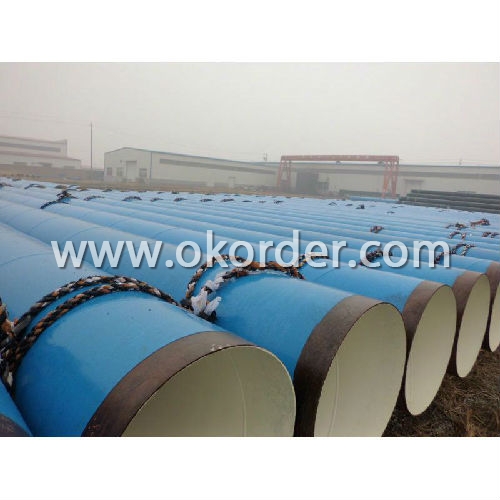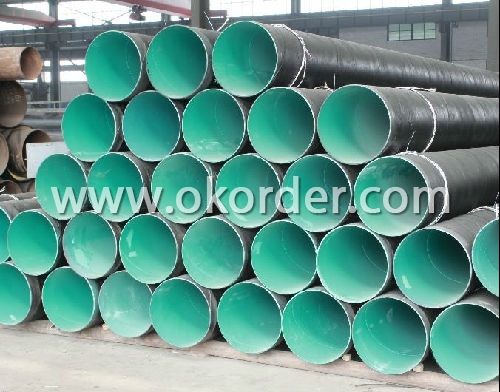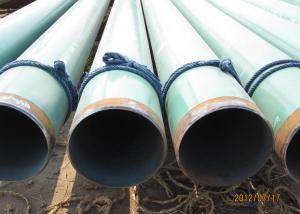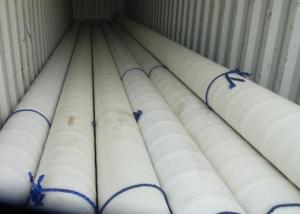3PE&PE&PP Coating Steel Pipe for Fluid 165mm-3340mm
- Loading Port:
- Tianjin Port
- Payment Terms:
- TT or LC
- Min Order Qty:
- 1t m.t.
- Supply Capability:
- 5000 Tons Per Month m.t./month
OKorder Service Pledge
OKorder Financial Service
You Might Also Like
order | item | performance | test method. | |
2PE | 3PE | |||
1 | peeling strength (N/cm)20±5℃ 50±5℃ | ≥35 ≥25 | ≥60 ≥40 | DIN30670 |
2 | cathodic disbanding(mm) (65℃,48h) | ≤15 | ≤10 | SY/T4013 |
3 | impact strength (J/mm) | ≥8 | DIN30670 | |
4 |
bending resistant (2.5°) | No cracking of polyethylene | SY/T4013 | |
5 | Pinhole (25kv) | No leak | DIN30670 | |
Specification of 3PE&PE&PP Coating Steel Pipe for Fluid 165mm-3340mm:
1.Materials Q235 Q345 ect.
2.Length Less than 18m
3.Thickness 5-30mm
4.Trade terms CIF CFR FOB
5.API GB/T DIN ect
Package and Delivery of 3PE&PE&PP Coating Steel Pipe for Fluid 165mm-3340mm:
Package:Marking ,Black painting , Bevel end ,Plasitc Cap .
Delivery:30-60days
Applications of 3PE&PE&PP Coating Steel Pipe for Fluid 165mm-3340mm:
petroleum, smelting, foodstuff, power, papermaking, chemical, medical equipment, aviation, boiler heat, exchanger, gas metallurgy, shipbuilding
Others of 3PE&PE&PP Coating Steel Pipe for Fluid 165mm-3340mm:
1.Special design available according to requirement
2.anti-corrosion and high-temperature resistant with black painting
3. All the production process are made under the ISO9001:2000 strictly.
At present, our company can undertake various external coating project fro steel pipes, like single or two-layer fusion bonded epoxy power FBE, 2PE, 3PE, 2PP, or other corrosion coating is used for them. We also can apply for the internal coating of cement Mortar inner wall pipeline. It can also undertake applications of anti-corrosion coatings and thermo-isolation cover for various metal storage tanks, metal vessel and other metal structure.


- Q:Can steel pipes be used for the construction of offshore platforms?
- Yes, steel pipes can be used for the construction of offshore platforms. Steel pipes are commonly used in offshore platforms due to their durability, strength, and resistance to corrosion. They can be utilized for various purposes such as structural support, transportation of fluids, and installation of equipment. Additionally, steel pipes are readily available, cost-effective, and can withstand the harsh marine environment, making them a suitable choice for offshore platform construction.
- Q:How are steel pipes used in the construction of telecommunications towers?
- Steel pipes are commonly used in the construction of telecommunications towers as they provide a strong and durable framework for supporting the tower structure. These pipes are used to create the main mast or tower structure, providing stability and strength to withstand various weather conditions. Additionally, steel pipes are often used for mounting antennas and other equipment on the tower, ensuring secure installation and efficient signal transmission.
- Q:What are the common standards for steel pipe manufacturing?
- The common standards for steel pipe manufacturing include specifications set by organizations such as the American Society for Testing and Materials (ASTM), the International Organization for Standardization (ISO), and the American National Standards Institute (ANSI). These standards cover various aspects such as size, dimensions, material properties, manufacturing process, and testing requirements to ensure the quality and consistency of steel pipes.
- Q:What are the different methods of joining steel pipes for oil and gas pipelines?
- There are several methods of joining steel pipes for oil and gas pipelines, including welding, threading, and flange connections. Welding involves heating the ends of the pipes and fusing them together, creating a strong and seamless joint. Threading, on the other hand, involves cutting threads on the pipe ends and using threaded fittings to connect them. Flange connections use flanges and bolts to join the pipes together, allowing for easy disassembly and maintenance. Each method has its advantages and is chosen based on factors such as pipeline design, specifications, and project requirements.
- Q:Can steel pipes be used for underground utility lines?
- Yes, steel pipes can be used for underground utility lines. Steel pipes are commonly used for various underground applications, including utility lines for water, gas, and sewage. They are durable, strong, and resistant to corrosion, making them suitable for long-term use in underground environments. Additionally, steel pipes can be easily welded and connected, allowing for efficient installation and maintenance.
- Q:How are steel pipes protected against mechanical damage during transportation?
- Various measures are implemented to safeguard steel pipes against mechanical damage during transportation. One commonly used technique involves the application of protective coatings or wrapping materials, typically composed of plastic, rubber, or epoxy. These coatings serve as a physical barrier, shielding the pipes from scratches, dents, and other forms of mechanical harm. Another method involves the utilization of padding or cushioning materials, such as foam inserts or rubber gaskets. These materials are inserted inside or wrapped around the pipes, absorbing any impacts or shocks that may occur during transportation. This effectively prevents potential damage caused by vibrations or bumps. Additionally, steel pipes are frequently secured and immobilized within transportation containers through the use of straps, braces, or other securing devices. These measures ensure that the pipes remain stable and do not collide with one another, thereby minimizing the risk of mechanical harm. Furthermore, proper handling and loading techniques play a crucial role in protecting steel pipes during transportation. This involves the utilization of appropriate lifting equipment, such as cranes or forklifts, to prevent any accidental dropping or mishandling of the pipes. Moreover, pipes are often stored or stacked in a manner that minimizes the possibility of deformation or bending. Ultimately, a combination of protective coatings, cushioning materials, securement devices, and proper handling techniques are employed to ensure the safe transportation of steel pipes and maintain their optimal condition for use in various applications.
- Q:How are steel pipes stored and transported?
- Steel pipes are typically stored in warehouses or open yards, stacked in an organized manner to prevent damage. They are often transported using trucks or railcars, secured with straps or clamps to ensure stability. For long-distance transportation, pipes may be bundled together or loaded onto flatbed trailers. Additionally, protective coatings are applied to prevent corrosion during storage and transportation.
- Q:What are the common applications of seamless steel pipes?
- Seamless steel pipes have numerous common applications in various industries due to their unique properties. Here are some of the most common applications of seamless steel pipes: 1. Oil and gas industry: Seamless steel pipes are widely used in the oil and gas industry for the transportation of oil, gas, and other fluids. They are preferred due to their high strength, durability, and resistance to corrosion, making them suitable for harsh environments. 2. Construction and infrastructure: Seamless steel pipes are extensively used in construction projects, including the construction of buildings, bridges, and tunnels. They are ideal for structural applications due to their ability to withstand heavy loads and provide excellent strength and stability. 3. Automotive industry: Seamless steel pipes are a crucial component in the manufacturing of automotive parts, such as exhaust systems, engine components, and hydraulic systems. They offer high strength, reliability, and resistance to heat, making them suitable for demanding automotive applications. 4. Mechanical and engineering applications: Seamless steel pipes find usage in various mechanical and engineering applications, including machinery, equipment, and manufacturing processes. They are commonly used for carrying fluids, gases, and steam, as well as for the transmission of power in machinery. 5. Power generation: Seamless steel pipes are extensively used in power plants for the transportation of steam and hot water. They are capable of withstanding high pressure and temperature, making them ideal for power generation applications. 6. Petrochemical industry: Seamless steel pipes are crucial in the petrochemical industry for the transportation of various chemicals, gases, and liquids. They have excellent resistance to corrosion, which is essential when dealing with hazardous and corrosive substances. 7. Mining industry: Seamless steel pipes are used in the mining industry for various applications, including the transportation of slurry, water, and other mining-related fluids. They offer durability, reliability, and resistance to abrasion, making them suitable for the challenging mining environment. 8. Aerospace industry: Seamless steel pipes find applications in the aerospace industry for manufacturing aircraft components, such as hydraulic systems, fuel lines, and structural parts. They provide high strength-to-weight ratio and resistance to extreme temperatures and pressure. Overall, the common applications of seamless steel pipes span a wide range of industries, thanks to their exceptional properties, including strength, durability, resistance to corrosion and high temperatures, making them an essential component in various industrial processes and infrastructure development.
- Q:What is the cost of steel pipes compared to other pipe materials?
- The cost of steel pipes is typically higher compared to other pipe materials such as PVC or copper.
- Q:How are steel pipes used in construction?
- Steel pipes are commonly used in construction for various purposes such as structural supports, plumbing systems, and underground utility installations. They provide strength, durability, and flexibility, making them suitable for carrying fluids, gases, and structural loads. Steel pipes are often used in the construction of buildings, bridges, and infrastructure projects, ensuring reliable and long-lasting performance.
1. Manufacturer Overview |
|
|---|---|
| Location | Cangzhou,China |
| Year Established | 2010 |
| Annual Output Value | 200 million square meters |
| Main Markets | Main land;Middle East;Southeast Asia |
| Company Certifications | ISO 9001 |
2. Manufacturer Certificates |
|
|---|---|
| a) Certification Name | |
| Range | |
| Reference | |
| Validity Period | |
3. Manufacturer Capability |
|
|---|---|
| a)Trade Capacity | |
| Nearest Port | Tianjin |
| Export Percentage | 41% - 50% |
| No.of Employees in Trade Department | less than 10 |
| Language Spoken: | English;Chinese |
| b)Factory Information | |
| Factory Size: | 20,000 square meters |
| No. of Production Lines | 2 |
| Contract Manufacturing | OEM Service Offered;Design Service Offered |
| Product Price Range | Average |
Send your message to us
3PE&PE&PP Coating Steel Pipe for Fluid 165mm-3340mm
- Loading Port:
- Tianjin Port
- Payment Terms:
- TT or LC
- Min Order Qty:
- 1t m.t.
- Supply Capability:
- 5000 Tons Per Month m.t./month
OKorder Service Pledge
OKorder Financial Service
Similar products
New products
Hot products
Related keywords






























